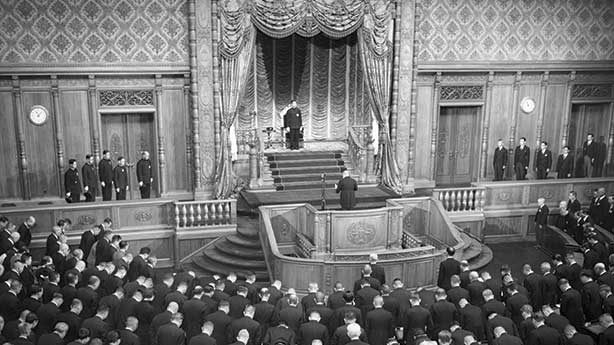 |
| Japanese Constitution (1947) |
Japan surrendered unconditionally after its resounding defeat in World War II. It was occupied by the U.S. military from 1945 to 1951 under the supervision of General Douglas MacArthur, supreme commander for the Allied Powers. MacArthur undertook fundamental reforms of Japan, one of the most important being the enactment of a new constitution in 1947, which became the underpinning of postwar democratic Japan.
General Douglas MacArthur first ordered Japanese government leaders to submit to him the draft of a new constitution, but he found it unsatisfactory. Then he ordered his general headquarters, under General Courtney Whitney, to produce a model draft that incorporated U.S. ideals, which was readied one week later, on February 13, 1946. Japanese leaders had few opportunities to make changes to it, and the final draft was published on March 6 and ratified by the Japanese legislature.
The constitution, which went into effect on May 3, 1947, was fundamentally different from the Meiji Constitution of 1889. It transferred sovereignty from the emperor to the people, making the emperor the "symbol of the state and of the unity of the people."
 |
 |
On MacArthur's order he had already renounced his claim of personal divinity in a proclamation on January 1, 1946. The constitution also gave women suffrage for the first time and granted them legal equality with men.
It essentially copied the British parliamentary system with a bicameral legislature, called the Diet: the lower or house of representatives, elected every four years, held power over the upper house of councillors, also elected (every six years), which replaced the previous House of Peers that had comprised many hereditary nobles.
The government was led by a prime minister selected from the Diet by its members. An independent judiciary was created under the supreme court, which was empowered to review the constitutionality of legislation. Article 9 of the constitution renounced war as an instrument of national policy, including the right of belligerence and the maintenance of all forms of war potential.
The goal of this article was to prevent Japan's reversion to its prewar militarism; 31 articles were devoted to human rights, patterned after the U.S. Bill of Rights. Two-thirds majorities in both houses were necessary to initiate changes in the constitution.
Although the United States was the catalyst for the fundamental changes embodied in the 1947 constitution, it remained unchanged after Japan regained sovereignty in 1952, indicating that the majority of Japanese were satisfied with its provisions.
The only significant modification pertained to the creation of a self-defense force in 1952. This was prompted by the United States, in recognition of the need for such a force during the cold war, and warranted because article 9 did not deny Japan the right of self-defense.
However, Japan's self-defense force remained small, at 235,500 troops in 1995, and likewise its defense budget, at around 1 percent of the nation's GDP. Japan relied on protection by the United States, established under the Mutual Defense Treaty of 1952.